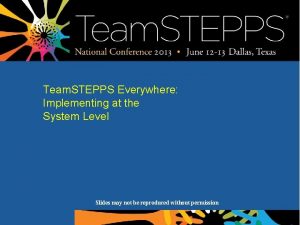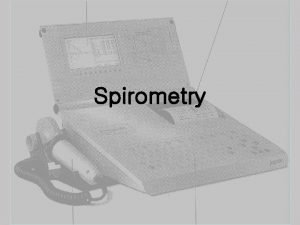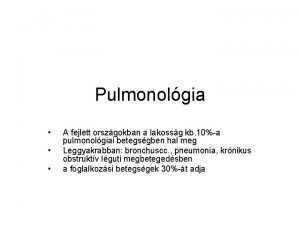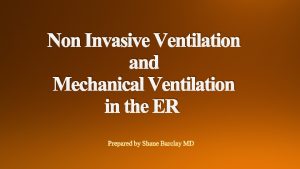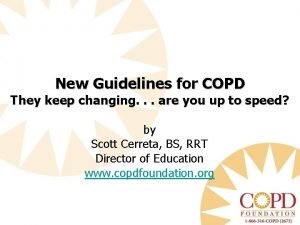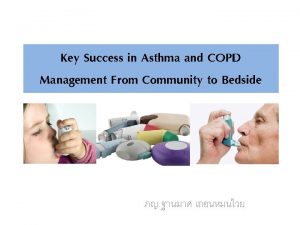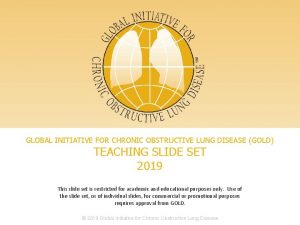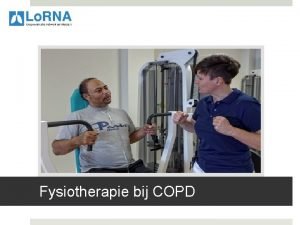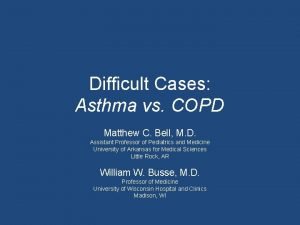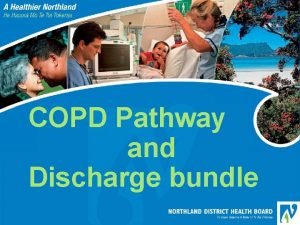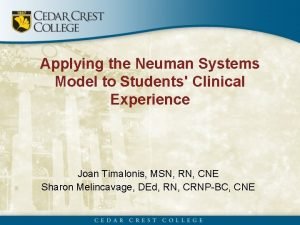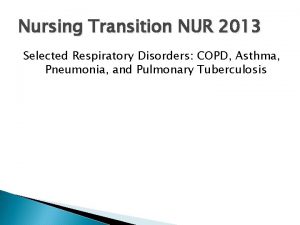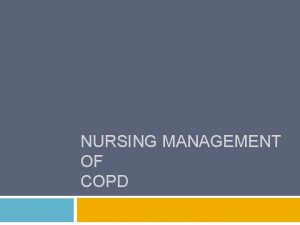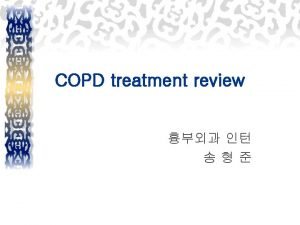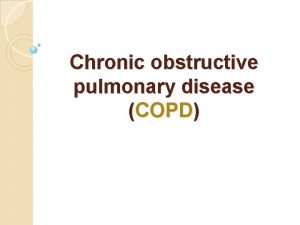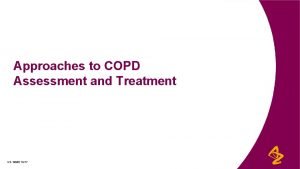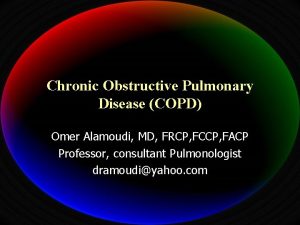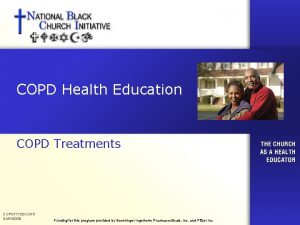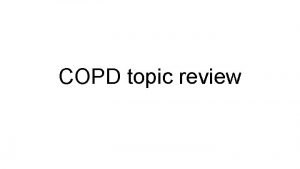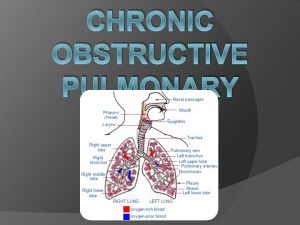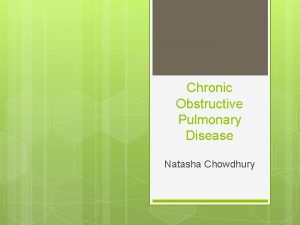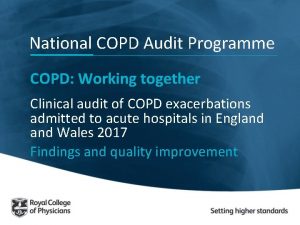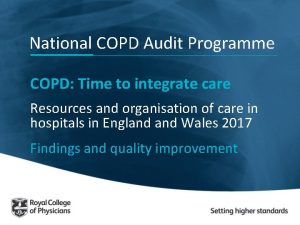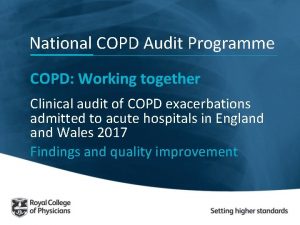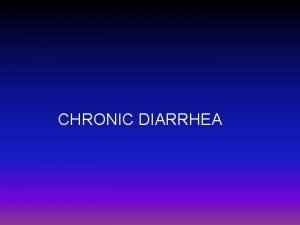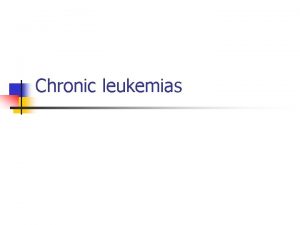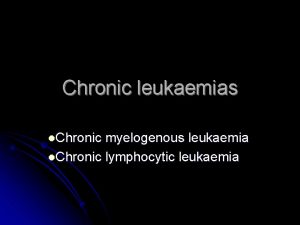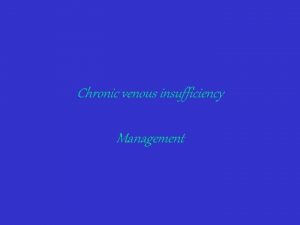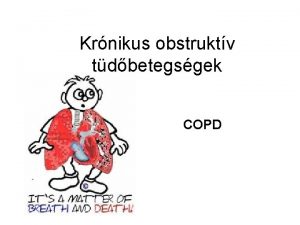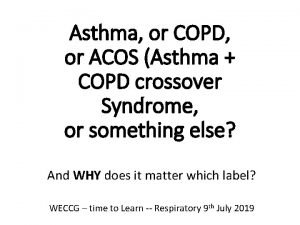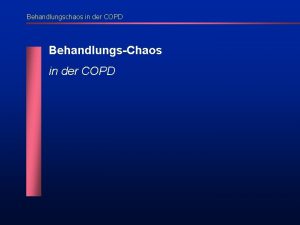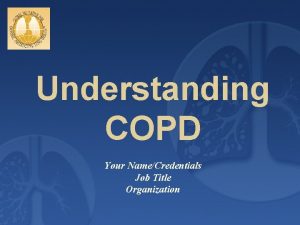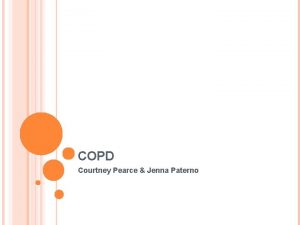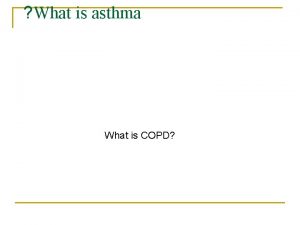COPD National Action Plan What is COPD Chronic
























- Slides: 24

COPD National Action Plan

What is COPD? • • Chronic obstructive pulmonary disease (COPD) is a progressive lung disease that over time makes it hard to breathe. Less air flows in and out of the airways because of one or more of the following: The airways and air sacs lose their elastic quality. The walls between many of the air sacs are destroyed. The airway walls become thick, and airways are narrowed by inflammation. The airways make more mucus than usual, which can also clog them. • Left untreated, people with COPD gradually lose their stamina and ability to perform daily activities.

Common Symptoms of COPD CONSTANT COUGHING, sometimes called a “smoker’s cough” SHORTNESS OF BREATH while doing everyday activities INABILITY TO BREATHE EASILY or take a deep breath EXCESS MUCUS PRODUCTION coughed up as sputum WHEEZING

Who Has COPD? • 16 million people are diagnosed, but millions more may have it and not know it 1, 2 • It is estimated that 1 in 5 Americans age 45 years and older has COPD 1, 2 16 Million Diagnosed BY GENDER 3 BY SMOKING HISTORY 1 OTHER 1 56% 44% 38% 25% WOMEN CURRENT OF CASES ARE NOT ASSOCIATED WITH DIRECT CIGARETTE SMOKING 37% FORMER

COPD: Challenges Public Health Burden is Large • • • A leading cause of death in the U. S. Causes serious, long-term disability. Kills >150, 000 Americans each year. 4 Available Treatments are Inadequate Self-Management Education and Smoking Cessation Bronchodilators IN CR E Inhaled Corticosteroids AS I NG SE VE RI TY Pulmonary Rehabilitation Oxygen Surgery

What is the COPD National Action Plan? • The first-ever blueprint for a multi-faceted, unified fight against the disease. • Developed at the request of Congress with input from the broad COPD community. • Provides a comprehensive framework for action by those affected by the disease and those who care about reducing its burden.

COPD Town Hall Meeting Set the foundation for the COPD National Action Plan More than 200 attendees – including patients, caregivers, health care providers, industry leaders, academic leaders, and 14 federal partners – participated Attendees separated into six breakout groups based on the original Action Plan goals and developed 18 recommendations February 29 and March 1, 2016

COPD National Action Plan Development Developed first draft of Action Plan based on suggestions from COPD Town Hall Meeting Solicited feedback on first draft Action Plan from COPD Town Hall attendees May 2016 June 2016 Revised the Action Plan and submitted for public comment Reviewed more than 200 public comments and updated Action Plan underwent final review and design Dec. 2016 April 2017 Sept. 2016 Released: May 2017

COPD National Action Plan Goals 1 Empower people with COPD, their families, and caregivers to recognize and reduce the burden of COPD. 2 Improve the prevention, diagnosis, treatment, and management of COPD by improving the quality of care delivered across the health care continuum. 3 Collect, analyze, report, and disseminate COPD-related public health data that drive change and track progress. 4 Increase and sustain research to better understand the prevention, pathogenesis, diagnosis, treatment, and management of COPD. 5 Translate national policy, educational, and program recommendations into research and public health care actions.

GOAL 1 Empower people with COPD, their families, and caregivers to recognize and reduce the burden of COPD.

GOAL 1: OPPORTUNITIES FOR ENGAGEMENT AND PARTICIPATION Share culturally and linguistically appropriate COPD risk assessment tools and educational materials with people with COPD and their families, friends, colleagues, and community members. Work locally with stakeholders, partners, and communities disproportionately affected by COPD to support disease awareness. Organize and support local events and activities at hospitals, during community events and activities, and as part of workplace wellness programs; seek local earned media coverage; and utilize existing health observances, including World COPD Day and National COPD Awareness Month. Develop and execute trainthe-trainer programs and distribute educational materials at state and federal levels that have unified messages and calls to action. Identify and engage new partners who can address COPD, particularly those with the ability to reach populations most affected by the disease, as well as those working on policies aimed at tobacco-use prevention.

GOAL 2 Improve the prevention, diagnosis, treatment, and management of COPD by improving the quality of care delivered across the health care continuum.

GOAL 2: OPPORTUNITIES FOR ENGAGEMENT AND PARTICIPATION Promote COPD assessment and treatment guidelines to health care professionals. Incorporate COPD detection, care, and treatment recommendations into clinical settings. Identify opportunities to increase health care professionals’ awareness and use of existing COPD training, tools, and model programs. Develop and offer culturally and linguistically appropriate patient resources, including referrals and support services, to further COPD education. Develop, support, and encourage participation in COPD training programs for health care professionals, particularly primary care practitioners. Use medical reminders for COPD risk detection during patients’ health care visits. Educate health care professionals about national COPD detection, treatment, and care guidelines. Ask health care professionals to assess patients for COPD, including the use of spirometry, as appropriate, and then develop a personalized, written (or digital, if preferred) management plan.

GOAL 3 Collect, analyze, report, and disseminate COPD -related public health data that drive change and track progress.

GOAL 3: OPPORTUNITIES FOR ENGAGEMENT AND PARTICIPATION Report the prevalence of COPD in accordance with the requirements of public health and health care organizations. Work with public health authorities to improve thoroughness and quality of COPD surveillance data. Use EHR/PHR technology to assess and evaluate the capacity to monitor and control COPD and Promote research that tracks the prevalence and incidence of COPD, including its phenotypes. related services. Collect detailed information about population-specific health disparities in COPD prevention, diagnosis, care, and treatment. Create or continue to build existing COPD patient registries that help evaluate and improve patient management, clinical care, and treatment. Support surveillance projects and epidemiological investigations to help understand the characteristics and needs of people at risk for and living with COPD. Create a common portal database and make its use publicly accessible in order to evaluate and enable predictive modeling.

GOAL 4 Increase and sustain research to better understand the prevention, pathogenesis, diagnosis, treatment, and management of COPD.

GOAL 4: OPPORTUNITIES FOR ENGAGEMENT AND PARTICIPATION Invest in, facilitate, and promote basic, clinical, and applied research to improve the diagnosis and treatment of people with COPD; assess the impact of the home environment on patient management and treatment. Create COPD patient registries that help evaluate and improve patient management, clinical care, and treatment. Invest in, facilitate, and promote the development, regulatory review and approval, and use of new technologies to improve the COPD care continuum. Promote the inclusion of information relevant to COPD in programs for training medical professionals and the next generation of biomedical scientists. Identify risk factors and targets for preventive interventions for chronic lung disease using ongoing NHLBI-supported cohort studies. Test the feasibility of strategies for the prevention of COPD and demonstrate proof of principle in early phase clinical studies. Leverage NHLBI-funded programs, such as Lung. MAP, to develop novel approaches for cell-based therapies and lung regeneration that could be applied in late-stage emphysema. Leverage observational cohorts, such as the NHLBIsupported COPDGene and SPIROMICS studies, to identify subgroups of patients with COPD in which particular molecular pathways or pathophysiological mechanisms are critical in pathogenesis. Develop and test panels of biomarkers that can be used to identify individual patients within these subgroups. Conduct clinical trials for COPD that are designed to allow analysis of efficacy in predefined subgroups of subjects, thereby providing an evidence base for precision medicine. This applies both to trials of drugs that target particular molecular pathways and to trials of other interventions, such as pulmonary rehabilitation. Design and test novel approaches for better implementation of effective strategies for the case finding, diagnosis, and treatment of COPD in the community, home, and primary medical care environments. Investigate the prevalence and incidence of COPD in nonsmokers to contrast and compare them — and their responsiveness to currently available therapeutics — to patients with cigarette- smokeinduced COPD. Investigate the biological effects of nicotine and its delivery devices and products to better understand emerging threats to lung health that may modify the onset or progression of COPD.

GOAL 5 Translate national policy, educational, and program recommendations into research and public health care actions.

GOAL 5: OPPORTUNITIES FOR ENGAGEMENT AND PARTICIPATION Create quality-control performance metrics for COPD detection, care, and treatment. Encourage the adoption and use of performance metrics for COPD detection, care, treatment, and prevention. Assess the progress of the COPD National Action Plan’s initiatives biannually. Share information about the COPD National Action Plan’s performance.

Dissemination & Implementation • • The entire COPD community owns this plan. All stakeholders have a role to play and must engage in its implementation. Patients and their Families Government Agencies Scientific Investigators and Physicians Public Interest Organizations and Advocacy Groups Professional Societies Industry Partners

How You Might Use the COPD National Action Plan WHICH GROUP DO YOU IDENTIFY WITH MOST? Patient, family member, caregiver, or at-risk individual Advocate or nonprofit Health professional Researcher Policymaker GOAL 1: GOAL 2: GOAL 3: GOAL 4: GOAL 5: Empower patients, their families, and caregivers to recognize and reduce burden of COPD Equip health care professionals to provide comprehensive care to people with COPD Collect, analyze, report, and disseminate COPD data Increase and sustain COPD research Turn COPD recommendations into research and public health care actions

How Can You Promote the Action Plan? • • Help bring visibility to the Action Plan among patients, caregivers, researchers, advocates, health professionals, policymakers, and anyone interested in COPD. Promotional materials available at COPD. nih. gov include: • Outreach toolkit • Videos and animations • Social media resources • Fact sheets • Executive summary • PDF of the Action Plan • FAQs • And more!

References 1) Anne G. Wheaton, Timothy J. Cunningham, Earl S. Ford, MD, and Janet B. Croft. , “Employment and activity limitations among adults with chronic obstructive pulmonary disease — United States, 2013, ” Morbidity and Mortality Weekly Report (MMWR), 64 (11), pp. 289 -295 (March 7, 2015), Centers for Disease Control and Prevention (CDC) 2) David M. Mannino, Robert C. Gagnon, Thomas L. Petty, and Eva Lydick. , “Obstructive lung disease and low lung function in adults in the United States: data from the National Health and Nutrition Examination Survey 1988 -1994. ” Archives of Internal Medicine, 160 (11), pp. 1683 -1689 (June 12, 2000) 3) Earl S. Ford, Janet B. Croft, David M. Mannino, Anne G. Wheaton, Xingyou Zhang, and Wayne H. Giles, “COPD surveillance — United States, 1999 -2011, ” Chest, 144 (1), pp. 284 -305 (July 2013) 4) Sherry L. Murphy, Jiaquan Xu, Kenneth D. Kochanek, Elizabeth Arias, and Sally C. Curtin. , “Deaths: Final Data for 2015. ” National Vital Statistics Reports, 66 (6), (November 2017)

COPD. nih. gov #COPDAction. Plan
 Copd national action plan
Copd national action plan National environmental education action plan
National environmental education action plan Action plan for senior citizens
Action plan for senior citizens Cbrn national action plan philippines
Cbrn national action plan philippines Patho
Patho Sbar copd
Sbar copd Asthma vs copd spirometry
Asthma vs copd spirometry Interstitialis rajzolat a tüdőben
Interstitialis rajzolat a tüdőben Bipap settings for copd
Bipap settings for copd Cat score copd
Cat score copd Blue and white inhaler
Blue and white inhaler Tam chứng anthonisen
Tam chứng anthonisen Gold asthma
Gold asthma Copd step up
Copd step up Mucusklaring
Mucusklaring Copd vs asthma
Copd vs asthma Lets be copd
Lets be copd Sbar copd
Sbar copd Barrel chested
Barrel chested Copd exacerbation nursing management
Copd exacerbation nursing management Copd 저농도 산소
Copd 저농도 산소 Bitemporal wasting in copd
Bitemporal wasting in copd Copd exacerbation nursing management
Copd exacerbation nursing management Copd abcd assessment
Copd abcd assessment Left parasternal heave
Left parasternal heave





